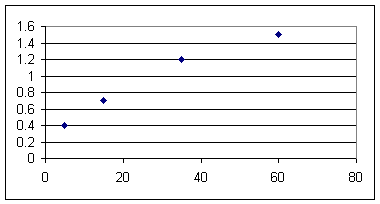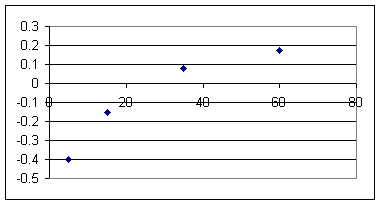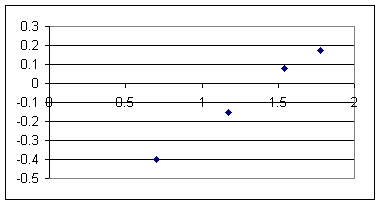
1112
http://www.vhcc.edu/dsmith/images/graph_series_1.htm
Length Period log(length) log(period) 5 0.4 0.699 -0.398 15 0.7 1.1761 -0.155 35 1.2 1.5441 0.079 60 1.5 1.7782 0.176 Graph period vs. length, log(period) vs. log(length), period vs. log(length) and log(period) vs. length.
Is any of these graphs linear?
T vs. L isn't linear.

log(T) vs. L isn't linear.

log(T) vs. log(L) is very nearly linear.

Slope of log(T) vs. log(L) is about .55 and y-intercept is close to -.9 (rough estimates).
So our equation is log(T) = .55 log(L) - .9.
Solving for T we get
10^log(T) = 10^(.55 log(L) - .8)
T = 10^-.8 * L^.55 or
T = .16 L^.55.
For what values of x is the function
equal to zero?
If x = 4, then x - 4 is zero so the product (x-4)(x+7) is zero.
If x = -7, then x + 7 is zero so the product (x-4)(x+7) is zero.
Are there any other values of x for which y = 0?
When we plug in we get two numbers, which we're gonna multiply. If one of those numbers isn't zero, we aren't gonna get zero for the product.
The only numbers that give us zero are therefore x = 4 and x = -7.
What does this tell us about the graph of y vs. x?
This tells us that the only points where the graph crosses the x axis are (-7, 0) and (0, 4).
What is the y-intercept of the graph of y = (x-4)(x+7)?
The graph crosses the y axis at the point where x = 0.
At this point we have y = (0 - 4) ( 0 + 7) = -28.
So the y intercept is (0, -28).
If x is a great bit huge humongous number, what can we say about the value of y?
y = (x-4)(x+7). If x is really huge, then x - 4 and x + 7 will both be really huge. So when we multiply them the result will be a really, really huge number.
What does this tell us about the graph?
It tells us that if we go far to the right, the graph gets really, really high.
Starting with
The left-hand side is just y; using the laws of exponents on the right-hand side we get
Since 10^(ab) = (10^a)^b the factor 10^(5 log(x)) = (10^(log(x))^5) so
So y is a power function of form y = A x^p with A = 10^7 and p = 5.
Starting with
The left-hand side is just y; using the laws of exponents on the right-hand side we get
Since 10^(ab) = (10^a)^b the factor 10^(5 x) = (10^5)^x so
This function is an exponential function of form y = A b^x with A = 10^7 and b = 100,000.
Generalizing:
If
then when we solve for y we get a power function.
If
then when we solve for y we get an exponential function.
If we have a table of y vs. x data, then if a graph of log(y) vs. log(x) gives us a straight line, we can find the slope m and the y-intercept b and get the equation log(y) = m log(x) + b.
Of a graph of log(y) vs. x is linear, then the slope and y intercept will give us the form log(y) = m x + b.